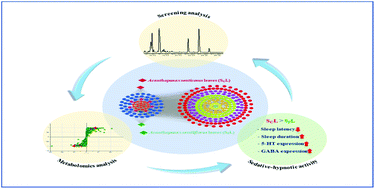Comprehensive phytochemical analysis and sedative-hypnotic activity of two Acanthopanax species leaves
Abstract
Acanthopanax senticosus leaves (SCL) and Acanthopanax sessiliflorus leaves (SFL), which are usually made into functional teas, possess similar pharmacological activities. With the aim of revealing their chemical compositions and evaluating their sedative-hypnotic effects, comprehensive metabolite profiling analysis based on ultra-high-performance liquid chromatography coupled to quadrupole time-of-flight tandem mass spectrometry (UPLC-Q/TOF-MS) and high-performance liquid chromatography with evaporative light scattering detection (HPLC-ELSD) as well as bioassay studies in mice were performed for the first time. Firstly, a total of 75 compounds (including 69 shared components) were identified or briefly characterized. Results indicated that the leaves of the two species were both rich in phytochemicals and contained similar structural types. Secondly, 20 and 7 chemical markers were identified from SCL and SFL, respectively. Five oleanane-type triterpene saponins (ciwujianoside C1, C3, D2, E and saniculoside N) and two lupine-type triterpene saponins (1-deoxychiisanoside and 24-hydroxychiisanoside) may be used for rapid identification of SCL and SFL. Thirdly, the contents of rutin, hederacoside D, ciwujianoside B, -C3, -E and ursolic acid in SCL (0.308%, 0.024%, 0.042%, 0.131%, 0.038%, and 0.255%, respectively) were higher than in SFL (0.067%, 0.005%, 0.012%, 0.015%, 0.002%, and 0.087%, respectively). Fourthly, an in vivo bioassay verified that both SCL and SFL could inhibit autonomous activity, shorten sleep latency and prolong sleep duration in a dose-dependent manner. To a certain degree, SCL showed a higher and more stable effect. The hypnotic effect could be inhibited by flumazenil (FLU). The two leaves not only had an obvious antagonism action of p-chlorophenoxyacetic acid (pCPA) but also showed a synergistic hypnotic effect with 5-hydroxytryptophan (5-HTP). The beneficial bioactivity may be mediated by 5-hydroxytryptamine (5-HT) and γ-aminobutyric acid (GABA). Finally, network pharmacology analysis showed that the undifferentiated and differentiated compounds were the material basis for the similar and the different activities of two leaves. Some typical chemical markers (such as saniculoside N, hederacoside D, ciwujianoside C3, -E and ursolic acid, 24-hydroxychiisanoside and 1-deoxyisochiisanoside) were the potential active compounds and could be used as quality markers in the future. The present study furnished a basis for the further development and utilization of the leaves of these two Acanthopanax species.



 Please wait while we load your content...
Please wait while we load your content...